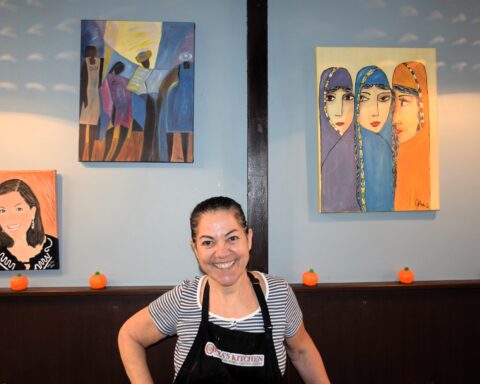It’s not a pipeline problem, said Nicole Tai, when it come to tech companies hiring people of colour. “It’s about companies putting effort in different places.”
Tai, 31, learned about the event Making a Career in Tech as People of Colour through Twitter and she said this type of event in Vancouver, one that represents most of her identity, is rare. And she’s not alone.
About 60 people showed up to the Tech In Colour event to hear panelists Arvinder Singh Kang, Julia Conejero and Sumeet Anand share their experiences in the tech industry. During the Q-and-A period, one attendee asked the panelists what could companies do to hire a more diverse staff. Kang, UrbanLogiq co-founder, said he tries to teach and foster more than one culture with his company. Having empathy and respect for each other will make space for more diversity he added.
“Try to be cognizant but don’t force it.”
Software test engineer Conejero said identify where the friction points are. “What makes applicants look at job postings and decide they don’t fit?”
She also said, “You can host workshops in computer languages your company uses. Hire from those who take them.”
Another option is to connect with continuing studies programs at post-secondary institutions because many mature students taking evening classes work full-time jobs but want to change their careers, she added.
As a former Facebook intern, Anand said Facebook has a university open to people of colour and underrepresented people to give them a launching point. It’s important to be able to see yourself in that space, she proclaimed.
“I got to see first hand that programs for inclusion do work,” Conejero vouched. “If your product is being used around the world, you can’t exclude talent that brings different ways of solving an issue.”
While she sees recruiters targeting people of colour, Conejero said the new challenge is retaining people of colour and to do so means creating an inclusive community.
Another suggestion Kang said was posting ads in native languages about internships. For example, in Surrey, try posting ads in Punjabi and see who shows up.
Reaching out to people of colour requires some creativity because immigrant students are often trying to survive in a new country, he explained. “They are working 40 to 60 hours a week and they’re unable to attend meet-ups. Check social media. Connect with influencers within a community.”
Don’t settle for companies and people who put diversity and being inclusive as an afterthought.
If it’s a core value, it is evident in its people, its language, and its environment.
— Nicolb (@nicolb) January 25, 2019
Get a mentor
During the first part of the event, panelists talked about getting into the tech industry and two main takeaways were mentorship and speaking up.
“Get a mentor,” Kang said. “It’s incredibly important to have someone who can be a second opinion and help pave the way. As a person of colour, it’s very important to develop this kind of communication so you can learn how to uplift people around you.”
Conejero added, “If you don’t have a mentor, look to peers, look to allies, and look to sponsors.” A sponsor being someone who will champion you to others, she explained.
For Anand, her mentor was a professor who fostered a safe space for students to critique each other’s work. “Different opinions matter.”
She also encouraged them to hold the door open for those coming into the industry.
Outside of school, Anand is a member of an art community and an online Indian community. She said online communities can also be an alternative if you’re having a hard time finding a mentor.
Finding online communities where you can share your work and get feedback in a safe and supportive manner is important for your health and progress as a POC in tech. It can also be an alternative if you’re having a hard time finding a mentor. // Sumeet Anand @techincolour
— Romila Barryman (@MsRomilaB) January 25, 2019
Be heard in the office
The other important action is speaking up at work.
Anand said, “When starting out, sometimes you don’t know when to speak up or stand up for oneself or for the team. You can slowly get your ideas on the table.”
She said there are ways to do so without feeling challenged often.
Kang said humour is a good way to get the message across without being confrontational.
For identifying when to speak up, Kang asks himself, “Would I feel bad not speaking up and this moment is gone?”
If the answer is yes, then he’d speak.
Another way to help him decide, Kang questions possible outcomes. He decides to say something and the recipient reacts negatively. “And then what?”
This internal dialogue helps him realize everything isn’t as bad as he imagines it to be and he can survive multiple outcomes.
If you’re nervous about speaking up at a meeting, Conejero has one useful technique that has served her time and time again. “Think about this: everyone poops.” This thought has helped her relaxed because it brings everyone down to the same level.
Deanna Cheng is a member of the NCM Collective based out of Vancouver.
Deanna Cheng is a freelance journalist who has been published in various publications such as Vancouver Courier and Asian Pacific Post. She often covers culture, intersectionality and Vancouver.





